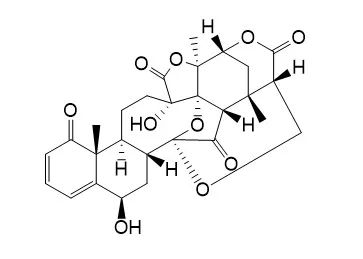| Description: |
Physalin G has antinociceptive property. |
| In vitro: |
| Pharmacogn Mag. 2016 May;12(Suppl 2):S231-6. | | Chemopreventive Agents from Physalis minima Function as Michael Reaction Acceptors.[Pubmed: 27279713] | The fruits of some varieties of genus Physalis have been used as delicious fruits and functional food in the Northeast of China.
METHODS AND RESULTS:
To reveal the functional material basis, we performed bioactivity-guided phytochemical research and chemopreventive effect assay of the constituents from Physalis minima.
It was demonstrated that the ethyl acetate extract of P. minima L. (EEPM) had potential quinone reductase (QR) inducing activity with induction ratio (IR, QR induction activity) value of 1.47 ± 0.24, and glutathione binding property as potential Michael reaction acceptors (with an α, β-unsaturated ketone moiety). Furthermore, bioactivity-guided phytochemical research led eight compounds (1-8), which were elucidated as 3-isopropyl-5-acetoxycyclohexene-2-one-1 (1), isophysalin B (2), Physalin G (3), physalin D (4), physalin I (5), physordinose B (6), stigmasterol-3-O-β-D-glucopyranoside (7) and 5α-6β-dihydroxyphysalin R (8) on the basis of nuclear magnetic resonance spectroscopy analyses and HRESIMS. Then, isophysalin B (2) and physordinose B (6) showed significant QR inducing activity with IR value of 2.80 ± 0.19 and 2.38 ± 0.46, respectively.
An ultra-performance liquid chromatographic method with glutathione as the substrate was used to detect the Michael reaction acceptors in extracts of Physalis minima (EPM).We investigated the chemical constituents of EPM guided by biological activity methodIsophysalin B (1) and physordinose B (6) showed strong quinone reductase inducing activity with induction ratio values of 2.80 ± 0.19 and 2.38 ± 0.46.
CONCLUSIONS:
This study generated useful information for consumers and many encourage researchers to utilize edible fruits from Physalis as a source of phytochemicals. |
|
| In vivo: |
| J Nat Prod. 2014 Nov 26;77(11):2397-403. | | Antinociceptive properties of physalins from Physalis angulata.[Pubmed: 25396337] | Pain is the most common reason a patient sees a physician. Nevertheless, the use of typical painkillers is not completely effective in controlling all pain syndromes; therefore further attempts have been made to develop improved analgesic drugs. The present study was undertaken to evaluate the antinociceptive properties of physalin B (1), physalin D (2), physalin F (3), and Physalin G (4) isolated from Physalis angulata in inflammatory and centrally mediated pain tests in mice.
METHODS AND RESULTS:
Systemic pretreatment with 1-4 produced dose-related antinociceptive effects on the writhing and formalin tests, traditional screening tools for the assessment of analgesic drugs. On the other hand, only 3 inhibited inflammatory parameters such as hyperalgesia, edema, and local production of TNF-α following induction with complete Freund's adjuvant. Treatment with 1, 3, and 4 produced an antinociceptive effect on the tail flick test, suggesting a centrally mediated antinociception. Reinforcing this idea, 2-4 enhanced the mice latency reaction time during the hot plate test. Mice treated with physalins did not demonstrate motor performance alterations.
CONCLUSIONS:
These results suggest that 1-4 present antinociceptive properties associated with central, but not anti-inflammatory, events and indicate a new pharmacological property of physalins. |
|






 Cell. 2018 Jan 11;172(1-2):249-261.e12. doi: 10.1016/j.cell.2017.12.019.IF=36.216(2019)
Cell. 2018 Jan 11;172(1-2):249-261.e12. doi: 10.1016/j.cell.2017.12.019.IF=36.216(2019) Cell Metab. 2020 Mar 3;31(3):534-548.e5. doi: 10.1016/j.cmet.2020.01.002.IF=22.415(2019)
Cell Metab. 2020 Mar 3;31(3):534-548.e5. doi: 10.1016/j.cmet.2020.01.002.IF=22.415(2019) Mol Cell. 2017 Nov 16;68(4):673-685.e6. doi: 10.1016/j.molcel.2017.10.022.IF=14.548(2019)
Mol Cell. 2017 Nov 16;68(4):673-685.e6. doi: 10.1016/j.molcel.2017.10.022.IF=14.548(2019)